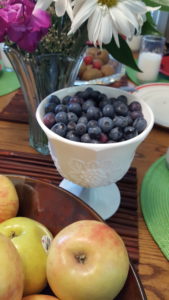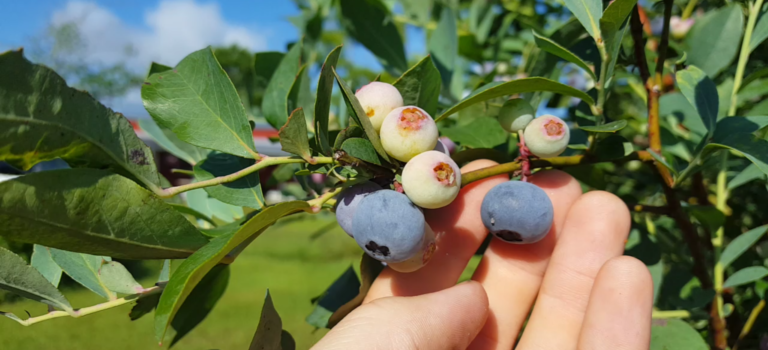
Dave went on a field trip this week with the family, and visited Poppy’s and Patty’s Blueberry Farm in Florala, Alabama “right off of Highway 54, right by mile marker 4.” He took a full tour of the farm and brought home a ton of fresh blueberries, which were promptly turned, into blueberry waffles – duh! If you haven’t seen the video of the tour yet, you can view it here: https://www.youtube.com/watch?v=h_SkKJlivAs. Blueberries are considered a superfood. In fact, blueberries are jam packed with vitamins, minerals, and several antioxidants including something called an anthocyanin. Anthocyanins are polyphenols – the blue in the blueberry is most likely a result of these. Polyphenols are essentially micronutrients and probiotics. They are also found in red wine, coffee, grapes, specific teas, cherries, and a few veggies as well. In the past, you may have heard these referred to as flavonoids. Flavonoids have been widespread in the past few years because of their known interaction with enzymes and genes to induce apoptosis (death of a cell) in cancer cells.

Now that the basic science of the fruit is out of the way let’s talk planting and growing. First, blueberries prefer a soil pH between 4.5 and 5.5. The pH scale goes from 0 being most acidic (literally hydro-sulfuric acid) to 7 being neutral (distilled water) and tops out at 14 which is most alkaline (like drain cleaner). If you are reading this article and your soil is red (think Georgia red clay) you are most likely alkaline and will need to include some additives in your soil to make the mix conducive for growing the berry. Never fear though, the additives are as easy as peat moss, leaf compost, and manure. You may also want to include an iron sulfate for densely packed soil or if you have that famous Georgia red clay. The rough mix on that would be about 10 pounds per every 100 square feet of dirt. If you go this route, be sure to split the application in half (to 5lbs each), and allow about 2 to 3 months between the applications. In addition to steering clear of fertilizers containing nitrates, focusing on ammonia based or urea based fertilizer instead. As the season progresses, check the pH in the soil regularly, and if the balance needs to be changed the easy amendments are agricultural lime or cottonseed meal.

Buy it on Amazon
Additionally, be sure that the area you pick to plant your berries is in full sunlight most of the day. The plants tend to prefer being planted at a depth of 1 foot and to have personal space of about 2 to 2 ½ feet between each one. If you want individual plants versus a hedge, spread them out about 6 feet apart. If you are transplanting sprouts be sure to loosen the soil around the roots before planting them. Once the berries are planted, you can mulch them with grass clippings or even sawdust if you happen to have some laying around. As the plants begin to grow, you want to prune back low growth, and the short off-colored branches. After first planting/transplant, it takes roughly 3-4 years for the plant to reach maturity. It is not recommended by most experts to let the plant produce berries within the first two years of planting.

However, as Dave says – “there is no perfect timing.” If you decide to let the plant grow without fruiting for a while, merely pinch back the flowers. This also works for reducing the number of berries on a plant to keep it from overproducing. Finally, if you choose to plant, experts say the best time is between December and January as they are still dormant. However, if you are further north, you might have to wait for the winter thaw before you can plant this marvelous fruit. As far as picking goes, most experts will tell you that the season is about a month long and starts towards the end of July. However, you will notice that Dave and company were picking in mid-May (in USDA Zone 8a) and had plenty of berries to take home. If they are blue, they are ready – Grow and Eat It!
